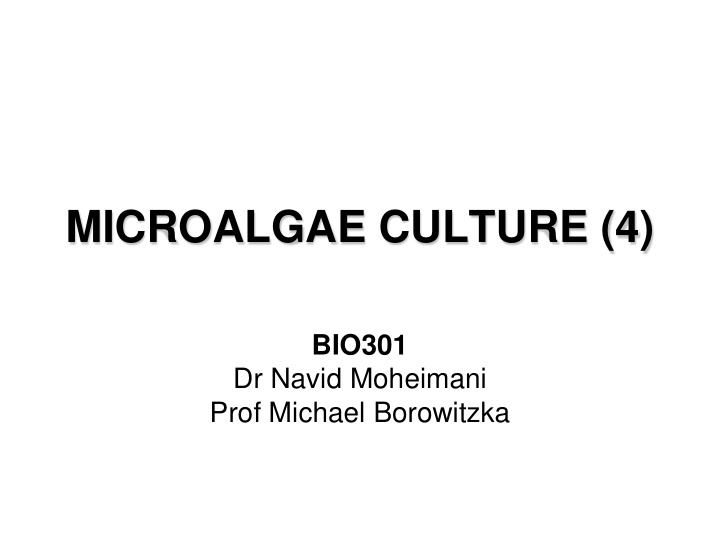



MICROALGAE CULTURE (4) BIO301 Dr Navid Moheimani Prof Michael Borowitzka
Flask Cultures
Flask Cultures
Carbuoy
Tubular Airlift Reactor
Commercial-Scale production Systems
Open ponds
Hutt Lagoon; WA
Whyalla; SA
Dunaliella & β -Carotene • β -Carotene formation depends on (a) total irradiance and (b) salinity • Optimum salinity for growth ~ 22% NaCl • Optimum salinity for β -Carotene formation > 30% NaCl • Nutrient limitation
Chlorella production - Taiwan
Chlorella production - Indonesia
Rores - Kolar, Karnataka, India
Spirulina Production Ponds, India
Earthrise Spirulina plant – Calipatria, California Curtesy – Ahma Belay
Ash-Free DW Lipid CaCO 3 Pleurochrysis carterae productivity – Perth, WA
Tank Culture - Hawaii
Cascade System – Trebon, Czech Repiblic
Closed Photobioreactors
Covered Ponds USA
Bag culture in Aquaculture Hatchery Bag Culture -
Haematococcus ‘tube’ culture in Israel Bag Culture - Israel curtesy – Ephraim Cohen
1000 L pilot-scale BIOCOIL at Murdoch University
Pilot Biocoil – Luton, UK
Comercial Haematococcus plant: Israel
Pilot CO 2 bioremediation plant operated by Greenfuel Technologies Corporation, USA at MIT.
Haematococcus plant operated by Algatech Ltd, Kibbuz Ketura, Israel
Alveolar panels
Capital Running Cell Relia- Cost Cost Yield bility Shallow Ponds * (1) ** (2) * * Raceways *** (2) *** ** ** Cascade *** (2) System **** ** **** Tubular Photobioreactor ****** **** *** **** Fermenter ***** (3) ******* ****** ***** 1 Depends on land & water cost as very large pond area required; 2 The range of species which can be cultured is very limited; 3 Heterotrophic culture is VERY much cheaper as no light required.
Algal Physiology, Bioreactor Design, Biochemistry & Engineering & Molecular Process Biology Control Light supply, Gas Photosynthetic efficiency, exchange, Turbulence, Secondary metabolism, Temperature control, ‘Stress’ tolerance, Materials, Harvesting, Strain improvement Downstream processing New applications, Economics marketing, formulation, packaging
Isolation & Screening • Algae strain result of a 20 year isolation & screening programme • Strains isolated from WA saline water sources and screened for suitability for large scale production • Detailed studies on growth, limits to growth and lipid production of most promising spp
Shear tolerance Rapid Growth Non-sticky High lipid content Grows in selective environment Temperature optimum Tolerate high O 2 High photosynthetic efficiency Heavy and large cells Ability to tolerate high irradiances Weak or no cell wall Salinity Lipid composition Ideally can release oil ( Botryococcus braunii )
Why the Pilbara? • Sunshine & Climate • Land • Water • Sources of CO 2 • Infrastructure • High local demand for diesel
Rio Tinto Power Station Algae Pilot Plant (0.01 km 2 )
100,000 bbl algal oil production (~ 10% of Australia’s daily consumption) 6.53 km 2 Algae Pilot Plant (0.01 km 2 ) 2 km 3.25 km
100,000 bbl algal oil production (~ 10% of Australia’s daily consumption) 6.53 km 2
Comparison of lipid productivity Lipid productivity t.ha -1 .y -1 Soybeans 0.44 Safflower 0.77 Sunflower 0.95 Rapeseed 1.18 Oil Palm 5.89 Our Alga in Pilbara, WA ~36.00
Recommend
More recommend